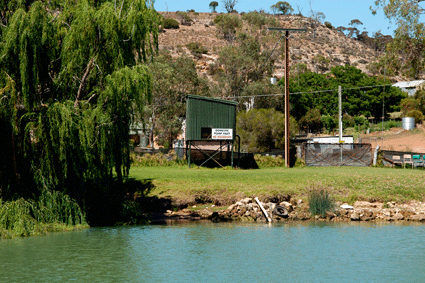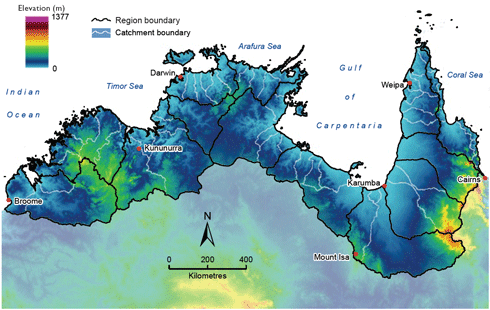
|
Published:
Addressing our groundwater crisis
Throughout Australia a growing number of domestic users as well as commercial and industrial organisations are relying on groundwater to compensate for shrinking surface water reserves. But in a drying climate it is a limited and potentially fragile resource. Now, clearer information about what constitutes sustainable consumption is evolving.
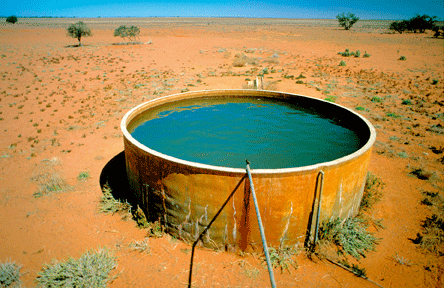
|
|
A bore water tank during drought near Mossgiel, NSW. Credit: Greg Heath, CSIRO
|
Until recently, Australia lacked the resources and information to manage groundwater systems properly. Over decades, bores have been sunk to water stock, irrigate crops and for domestic use. And while licences were required to extract groundwater in non-urban areas, few bores had metering. Just how much water was being extracted was not always properly understood.
‘Since the heyday of the Great Artesian Basin [a vast aquifer running from the Great Dividing Range to Lake Eyre] when you could drill a bore and hey presto, there was water, Australians have held something of a “magic pudding” attitude to underground resources,’ says Matt Kendall, General Manager of the National Water Commission’s water science group. ‘People would say “we’re on bore water” and assume it was fine to use as much as they liked. Well no, it isn’t.’
Today, groundwater measuring equipment and infrastructure are still very limited, but new research has been highlighting a usage crisis.
Dr Glen Walker, Theme Leader, Regional Water, from CSIRO’s Water for a Healthy Country Flagship, reinforces that fact. ‘The main issue facing groundwater in Australia is over-extraction, primarily for irrigation and stock watering purposes, although some towns are also reliant on underground reservoirs,’ he points out.
‘Continuing water scarcity and climate change are also placing pressure on reserves, but when too much groundwater is extracted, water tables drop and the remaining groundwater can become more saline.’
There are also consequences for groundwater-dependent ecosystems and for other users downstream of extraction sites, with landowners expressing concern that upstream extraction has caused groundwater to dry up on their own property or for subsidence to occur.
Through recent initiatives to measure and monitor Australia’s shrinking water resources, research is now extending to better quantify the extent of groundwater reserves and how they relate to surface water flows.
‘Although the exact mechanisms aren’t always clear and vary from one region to the next, groundwater is closely linked to rivers, wetlands, lakes and ponds on the surface. When groundwater dries up, so too do dependent ecosystems,’ Dr Walker continues.
‘Streams can lose water to groundwater and vice-versa.’ This is particularly significant in northern Australia where there is high, episodic rainfall for a few months then high evapotranspiration for the rest of the year – streams are dry except where they are fed by groundwater.
‘Some of Australia’s groundwater has also been lying underground for thousands of years; it’s a paleo-resource that last recharged in a past, wetter climate 10 000 years ago,’ adds Dr Walker. ‘And in the Murray-Darling Basin, where considerable work has been done to understand groundwater through the recent Murray-Darling Basin Sustainable Yields Project,1 the normal process of floods recharging some aquifers has not occurred during the prolonged drought.’
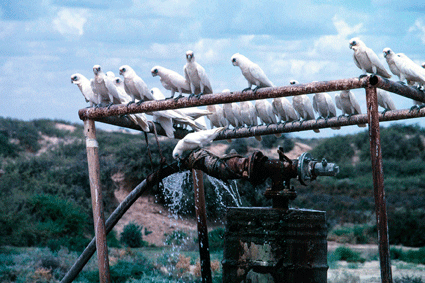
|
|
A flock of little corellas (Cacatua sanguinea) drink from a leaking bore water pump. Credit: CSIRO Sustainable Ecosystems
|
Researching sustainable use
Failure to understand the importance of groundwater recharging, and years of managing groundwater and surface water as two separate entities, led to separate extraction licences being granted for the same water resource and to some double accounting of water. A 2008 CSIRO study2 conducted as part of the Sustainable Yields Project found groundwater use or allocations, if fully taken up, could not be sustained in seven of the Basin’s 20 major irrigation areas.
It was heavily over-allocated.
‘We’ve seen a big shift in attitudes to groundwater,’ says Professor Craig Simmons, Director of the National Centre for Groundwater Research and Training (NCGRT), a national consortium of research and industry organisations throughout Australia, headquartered at Adelaide’s Flinders University. ‘It was only a few years ago that we barely heard anything at all about it, but recently a lot of positive initiatives have been undertaken, including widespread monitoring and management programs being funded by the National Water Commission.’
The $82-million national Groundwater Action Plan is funding groundwater investigation programs aimed at mapping reserves across the country. It also includes the NCGRT, which is helping to develop the skills and build the capacity needed to manage the resource, and education programs aimed at raising awareness of groundwater in the wider community.
‘Another $15 million in federal funding [through the Super Science scheme] has just been made available for additional groundwater monitoring and to establish vital new infrastructure at key sites that will help us both better understand and manage our groundwater resources,’ says Simmons. ‘We will get much better data to inform our understanding of groundwater flow rates, linkages between ground and surface water, and the potential future impacts of climate change.’
While there has been progress with the advent of water rights, water trading and the commoditisation of water, experts agree that much better information, and transparency into decision-making processes, is the key to managing groundwater effectively.
‘Too often governments are forced to make policy about groundwater without much knowledge or information about the resource,’ comments Simmons. He cites the recent moratorium on new domestic bores in Adelaide, which was imposed without rigorous discussion or debate after years of virtually unrestricted groundwater access.
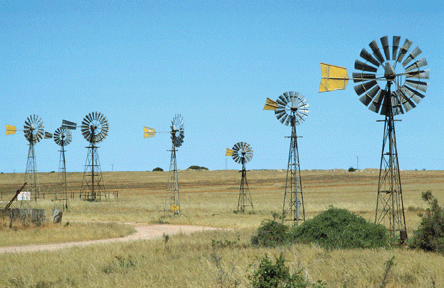
|
|
A cluster of windmills pumping groundwater at Penong, SA. Credit: Willem van Aken, CSIRO
|
Commercial extraction weighed up
In NSW’s Liverpool Plains region, BHP Billiton’s controversial plans to mine coal in a huge area of prime farming country have caused outrage among local farmers concerned that the mining works will damage the area’s underground water resources. But Glen Walker says ‘it is actually difficult to get good information on Liverpool Plains, and if coal-mining is not going to underlie alluvial aquifers, the impact actually may be small.’ The community is awaiting further advice.
Similarly, near Sydney, Coca Cola Amatil (CCA) was granted commercial access to Peats Ridge Spring, an ancient water body, for what is widely regarded as a pittance. The volumes being extracted by the beverage company for sale as bottled water have provoked considerable public discussion, but according to Glen Walker, currently 2.5 gigalitres per year (GL/yr) are extracted from the Mangrove Mountain aquifer, a third of the 8 GL/yr extraction limit. Of this, CCA extracts 0.07 GL/yr; as a proportion of total extraction, CCA’s consumption doesn’t appear excessive, but Walker believes better information on groundwater-dependent ecosystems might help lower extraction limits which could also have commercial consequences.
It is unlikely any measures to restrict commercial activities that negatively impact depleted groundwater resources will be welcomed: moves to reduce agribusiness giant ICM’s water entitlements resulted in a High Court challenge questioning whether the compensation proposed by the government accurately reflected the value of the entitlement.
‘As over-allocated systems are brought back to sustainable levels of development, there will need to be losers and claims of compensation,’ Walker comments, adding that greater knowledge will help avoid similar situations.
Professor Simmons adds: ‘There are a great many biophysical, social, economic and policy questions still to be discussed when it comes to groundwater. If we’re not careful we will have inequities where certain consumers have access to underground reserves but others don’t.
‘Before any major decisions are made about how we use any of these resources, we need to ensure we have all of these angles covered. We’ve also got to make sure we are thinking very carefully about future generations and not just our own.’
|
A new project, part of the government’s $12.9-billion Water for the Future Program, will investigate how climate change may affect rainfall, and what water is lost through evaporation and water use by plants. It will then determine the impact of these factors on groundwater recharge and base flows to water systems at a regional level, and will build on the Sustainable Yields work undertaken by the CSIRO in the Murray-Darling Basin, northern Australia, south-west Western Australia and Tasmania. |
1 Widely recognised as the world’s most complete water audit, the Murray-Darling Basin Sustainable Yields Project is just one of a raft of new initiatives aimed at understanding the whole of the water cycle.
2 CSIRO (2008) ‘Water availability in the Murray-Darling Basin’. Summary report from CSIRO to the Australian Government.


